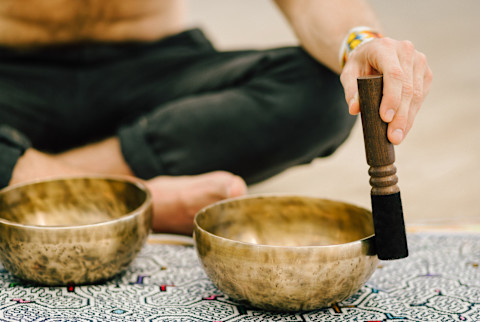
The human body is designed to be exquisitely sensitive to sound.
In utero, our ability to hear develops by about 18 weeks, making it one of the earliest senses to develop. By the end of the second trimester, research has shown that a fetus responds specifically to the sound of a mother's voice1. Doctors and hospice workers speculate that in the final moments of life, senses depart one at a time with hearing being the last to go—which is why we're advised to keep talking to our loved ones even after it seems they are no longer cognizant. Hearing is, in this way, one of our first and last modes of connection.
And as science begins to understand more about the healing vibratory quality of sound, modern sound therapy is catching up with the wisdom of the ancients.
The power of vibration.
Though the sounds we might imagine are something like voices or music, from a pure physics perspective, sound is silent. When we experience sound, what is actually happening is vibrations are passing through matter—be it a gas, fluid, or solid—in the form of a wave.
Think of it like a slinky stretched between two people: If one person gives their end a push, the slinky ripples forward until it reaches the other person, then bounces back, continuing on and on.
When considering the ways we have evolved to be giant sound conductors—our skin, bones, ears, as well as the water that makes up a large percentage of our bodies all pick up sound waves—it makes sense that both inaudible and audible vibrations would have a profound effect on us.
Cellular antennas.
Recent research shows that we pick up both audible and inaudible sound all the way down to a cellular level: In 2015, a study was published by biomedical engineering researchers from Columbia University building on the groundbreaking discovery that antenna-like structures containing an array of proteins on our cell membranes, called primary cilium, receive and respond to vibrational energy fields such as sound, light, and radio frequencies.
If a vibration in the environment resonates with the receptor's antenna, it alters the proteins' charges, causing the cell to change shape. This is a breathtaking discovery, given that defects in the primary cilium have been linked to illnesses as wide-ranging as arthritis, polycystic kidney disease, obesity, heart failure, and cancer.
And if this structure is indeed receptive to such vibrational frequencies, the implication—one that is currently being researched—is that sound waves may have the capacity to reshape cell structures in a way that could help treat these illnesses.
Applying sound therapy.
This is the very principle that sound medicine is built on: When we are ill, the body's natural order of frequencies is altered, but when we are exposed to certain external vibrations in sound, our internal rhythms can be calmed or restored.
For example, music therapy has been found to be helpful in reducing depression and anxiety. A 2009 review of 23 studies covering almost 1,500 patients found that listening to music reduced heart rate, blood pressure, and anxiety in heart disease patients.
This idea has been passed on through history from many cultures—ancient Egyptians, Aborigines, Tibetan monks, Native American shamans, and Vedic masters among them. These groups have variously used chants, mantras, song, and musical instruments to restore the vibratory frequencies of the body and mind, understanding instinctively what scientists were later able to prove: There is a direct relationship between environmental sound and our physiological health.
Although sound medicine as it was practiced by the ancients is beginning to reemerge in modern medicine, we haven't yet embraced the capability and dynamism of the human body and spirit. If, though, we can synthesize the evidence-based practice of Western medicine with the metaphysical concepts of ancient cultures and alternative medicine, we will be rewarded with stunning discoveries.
